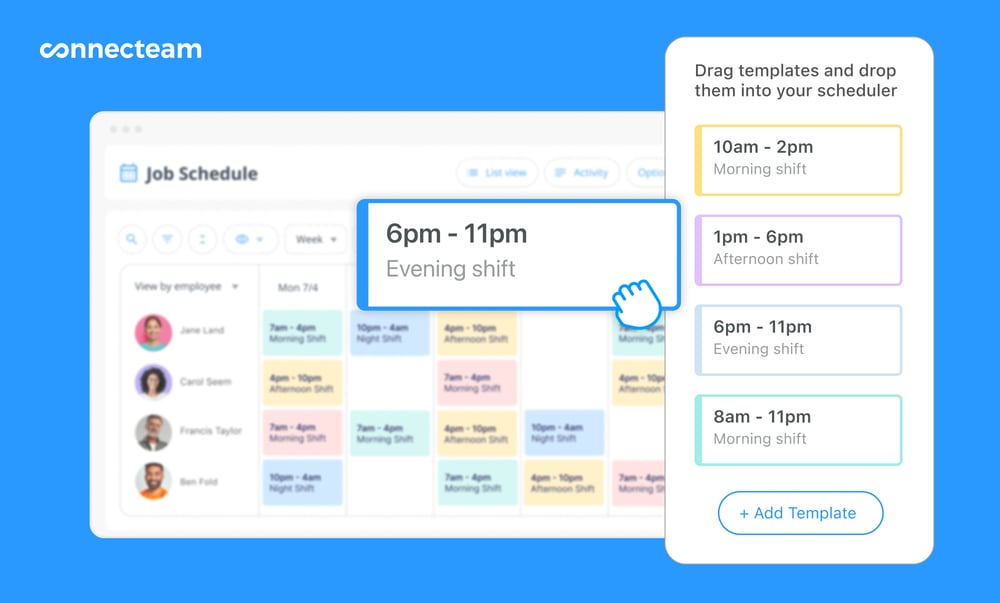First shift, also known as the day shift, typically runs from 8:00 a.m. to 4:00 p.m. It’s common in many industries such as healthcare and retail and offers better work-life balance and consistent routines.
Key Takeaways
- The first shift, or day shift, is the most common work shift, typically running from 8:00 a.m. to 4:00 p.m.
- Some businesses use a standard 8-hour shift structure for the first, second, and third shifts, while others define them based on their specific operating hours.
- Many industries rely on first shifts, including factories, hotels, retail, healthcare, and delivery companies.
- The first shift offers better work-life balance, natural light exposure, consistent routines, and more social opportunities than the second and third shifts.
- Challenges include early mornings, rush hour commutes, potential work overload, and limited flexibility for evening commitments.
Ever wonder how the world keeps running 24/7?
Shift work plays a crucial role, with different schedules catering to businesses that operate beyond the standard 9-to-5.
In this article, we’ll explore the most common working block: first shift. We’ll go over the typical hours, the industries that rely on this type of shift, and the advantages and disadvantages for employees.
Whether you’re considering a first-shift job or managing a team that works these hours, you’ll learn valuable insights to help you navigate the world of daytime schedules.
What is First Shift?
First, second, and third shift schedules are often used by businesses that operate 24 hours a day.
First shift, also known as the day shift, is the first shift of the day and starts in the morning and goes through the afternoon.
It’s the most commonly worked shift in the US and typically starts around 8:00 am and ends around 4:00 pm, although the exact times can vary depending on the industry and company.
A traditional example of this type of schedule looks like this:
- First shift: 8:00 am-4:00 pm
- Second shift: 4:00 pm-12:00 am
- Third shift (also known as the graveyard shift): 12:00 am-8:00 am
However, businesses can define for themselves how to split up first, second, and third shifts.
For example, a restaurant open for breakfast, lunch, and dinner from 7:00 am-10:00 pm may define shifts like this:
- First shift: 6:00 am-11:00 am
- Second shift: 11:00 am-4:00 pm
- Third shift: 4:00 pm-10:00 pm
Did You Know?
Some businesses may use swing shifts in addition to first, second, and/or third shifts. Swing shifts are shorter shifts often used to cover peak hours or bridge the gap between them.
For example, a coffee shop might have a swing shift from 2:00 pm-10:00 pm, covering the afternoon lull and ramping up for the evening rush.
Typical First Shift Industries
These are some common types of businesses that work first shifts:
- Factories and manufacturing
- Hotels
- Cleaning companies
- Nurses and other hospital workers
- Hair salons and barbershops
- Non-emergency medical clinics
- Retail stores
- Grocery stores
- Delivery companies
Keep in mind that this list is not exhaustive. Also, some businesses within these categories might have extended hours or operate on weekends, requiring employees to work beyond a traditional first-shift schedule.
First, Second, and Third Shifts: Pros and Cons
Deciding how to schedule your employees depends on several factors, including employee preference and availability. Some businesses may prefer to use a rotating schedule in which you rotate employees through each shift every few weeks to keep things fair.
Let’s go over some of the key pros and cons of each type of shift from both an employee and manager perspective:
First shift
Pros
- Aligns better with daytime routines: First shift occurs sometime around the standard 9-5 working hours, so it’s easier to coordinate personal errands and family activities.
- Increased motivation: According to a 2022 study, employees who work standard daytime hours are more likely to feel more motivated in their jobs.
- Better health: More exposure to natural light during the day can positively affect mood and overall health.
- Consistent routine: A consistent daily routine can improve sleep quality and overall well-being.
- More social opportunities: More opportunities for social activities in the evening with family and friends. First shift also aligns better with childcare and school schedules, which can be ideal for parents.
- Consistent meal times: Most employees will get a lunch break during the day, keeping their bodies in line with standard meal times.
Cons
- Morning rush: Coming to work for first shift usually means driving in traffic during rush hour. This can lead to a longer commute.
- Early wake-up: People who enjoy staying up late may struggle to wake up early in time for work.
- Work overload: First shift is often the busiest shift with the highest workload and most customer interactions. Employees with customer-facing roles often face the brunt of customer inquiries, phone calls, and an overall busier shift. This increased workload can leave them feeling overwhelmed and struggling to complete all their tasks within the workday.
- Limited flexibility: First shift is less flexible for those who may have other responsibilities or interests that are better suited for later in the day.
Second shift
Pros
- Avoid morning traffic: Commutes are often less congested compared to the morning rush hour.
- Flexible mornings: Employees have free time in the mornings for personal errands, appointments, or additional sleep.
- Potential for higher pay: Some employers offer higher pay rates for evening shifts.
- Less busy environment: Workplaces may be less crowded and hectic compared to the first shift.
Cons
- Limited evening social life: Employees have less time for evening social activities and family events.
- Disrupted sleep patterns: Working late can disrupt natural sleep patterns, leading to sleep deprivation and health problems.
- Inconvenient meal times: Dinner is often rushed or skipped, which can affect diet and health.
- Potential isolation: Staff have less interaction with daytime shift workers and may feel isolated from the team.
- Poor customer service: Customer service during second shift can suffer. There are a few reasons for this: second shift isn’t as busy as the first, and often times, employees are already tired from being awake for so many hours.
Pro Tip
Use an employee management app, like Connecteam, to keep staff aligned, engaged, and motivated, no matter what shift they’re working. With multiple communication channels and employee recognition and rewards, you can keep your team connected no matter where they’re working.
Third shift
Pros
- Higher pay: Night shifts often come with higher pay rates and additional benefits.
- Quieter environment: Typically, the work environment is quieter with fewer distractions.
- Daytime flexibility: The entire daytime is free for personal activities, appointments, or secondary jobs.
- Less supervision: There is often less direct supervision, which can lead to more autonomy in the role.
Cons
- Health risks: Increased risk of health issues such as sleep disorders, heart disease, and metabolic problems.
- Social isolation: Limited time for socializing with family and friends who follow a regular daytime schedule.
- Sleep disruption: Difficulty maintaining a consistent sleep schedule, leading to chronic sleep deprivation.
- Safety concerns: There is an increased risk of accidents due to fatigue and lower alertness levels at night.
- Lower morale: Night shift workers may have lower morale than other employees because they may feel less connected to the team, which can inhibit motivation.
This Might Interest You
You can keep your team aligned and connected no matter what shift they work. For expert time, check out our complete article on how to boost employee morale.
How Should I Decide Which Employees to Schedule for First Shift?
Scheduling can seem daunting, and the more hours your business is open, the more complicated it can get.
Here are some factors to consider when deciding which employees should work first shift:
Employee preferences
When hiring new employees, make sure to ask them what shifts they prefer to work. This is the best way to get this information right off the bat. You can also conduct employee surveys of your current staff to gauge their work preferences and to gain insights into their needs.
You should also consider individual needs, like childcare arrangements, school schedules, or second jobs that might influence shift preference.
In some companies, seniority can play a role. Employees with more experience might get preference on preferred work times, like the first shift.
Job requirements and skills
Match employee skills to specific shift needs. For example, first shift might require strong communication skills for customer interaction, while a quiet night shift might be ideal for less outgoing employees.
You may also want to place more experienced employees on shifts that require more training or supervision, particularly during busier first or second shifts.
Work-life balance
Try to accommodate employees with limitations. For example, single parents who need time for childcare during the day may not want to work first shift.
If it works for your business, rotate shifts fairly when possible.. You can rotate everyone through each shift so every staff member gets a chance to work more desirable shifts, like first shift, and to avoid burnout from undesirable ones, like third shift.
Additional scheduling tips
Legalities of shift work
As you decide on employee schedules, here are some key legal considerations to keep in mind:
- Fair Labor Standards Act (FLSA): This federal law applies to most non-exempt employees (those entitled to overtime pay). The FLSA generally doesn’t regulate how many hours an employee works per day or week. However, it mandates overtime pay (one and a half times their regular rate) for any hours exceeding 40 in a workweek. Keep this in mind when considering who you may need to schedule for overtime.
- Minimum wage laws: Most states have minimum wage laws that set the lowest hourly rate an employer can pay. Ensure your scheduling practices, including overtime, comply with these requirements.
- Predictive scheduling laws: Some states and localities have predictive scheduling laws, which aim to protect shift workers from exploitation. Some jurisdictions give employees the right to ask for flexibility with their hours and to refuse shift-change requests. They also place a range of obligations on employers.
- Meal and rest breaks: Many states have laws requiring meal and rest breaks for employees working certain lengths of time. These breaks are typically unpaid, but employees cannot be forced to work through them. Review your state’s labor laws to understand specific requirements for breaks during shifts.
- Disability accommodations: Employers are required by law to provide reasonable accommodations for qualified employees with disabilities. This might involve modifying schedules to accommodate medical needs or childcare restrictions.
Other scheduling tips to keep in mind include:
- Consider past performance: Reliable and productive employees might be better suited for first or second shifts where customer interaction is higher.
- Prioritize safety: For physically demanding jobs like construction, consider fatigue on late-night shifts and assign younger, more energetic employees.
- Think about teamwork: Ensure each shift has a good mix of skills and personalities to ensure smooth operations.
Company needs: Ultimately, company need plays a role. Busier first shifts might require more staff, while fewer employees might be sufficient for the night shift.
Pro Tip
Because some staff might find second and third shifts less desirable, providing incentives, such as small gifts or gift cards, is a great way to boost morale and motivation. Even something as simple as giving individual shout-outs on a job well done on your company updates feed can leave employees feeling recognized and appreciated.
Create Seamless Shift Schedules With the Right Software
Scheduling your team properly can be made much easier with the right scheduling software.
Connecteam’s employee scheduling app provides all the tools you need to create, manage and publish shift schedules, even while on the go.
The app also comes with a GPS-enabled employee time clock so staff can clock in and out right from their phones. Conncteam also includes integrations with leading payroll software including Quickbooks, Gusto, Paychex, and Xero.
Here are a few of Connecteam’s key shift-scheduling features to help you streamline the process:
- Drag-and-drop shift scheduler: Create customized schedules with whatever shifts you need using shift templates. The app will also flag you if you accidentally create errors, such as double scheduling or scheduling an employee who’s on PTO.
- Auto-scheduling: Predefine how many staff and which roles you need per shift, and the auto-scheduler will create the schedule for you, taking into consideration employee availability, preferences, skill sets, and business needs.
- Digital shift swapping: Employees can request to swap shifts with each other directly from the Connecteam app, and you can approve or deny them. Once you approve a swap, the app will automatically update the schedule and send notifications to anyone whose hours or days have changed.
- Break and overtime management: Connecteam automatically alerts employees when they need to take a break. You can also set the app to automatically notify you when an employee approaches overtime. This helps you better manage overtime pay, reduce the amount you spend on payroll, and ensure compliance with labor laws.
Teams of up to 10 people can get Connecteam’s employee scheduling software free for life, and the platform’s paid plan starts at just $29/month for up to 30 users.






